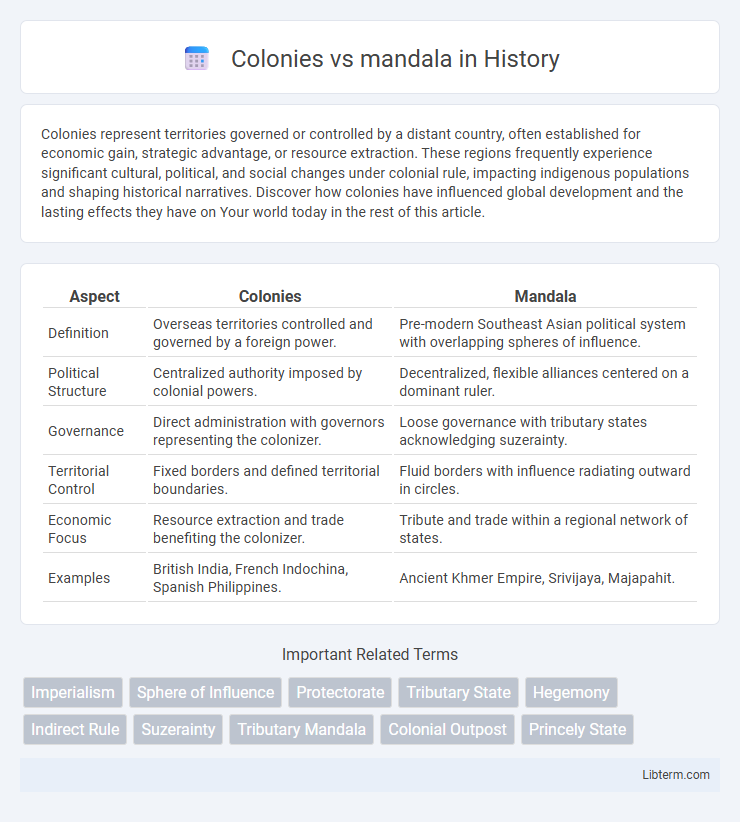Colonies represent territories governed or controlled by a distant country, often established for economic gain, strategic advantage, or resource extraction. These regions frequently experience significant cultural, political, and social changes under colonial rule, impacting indigenous populations and shaping historical narratives. Discover how colonies have influenced global development and the lasting effects they have on Your world today in the rest of this article.
Table of Comparison
| Aspect | Colonies | Mandala |
|---|---|---|
| Definition | Overseas territories controlled and governed by a foreign power. | Pre-modern Southeast Asian political system with overlapping spheres of influence. |
| Political Structure | Centralized authority imposed by colonial powers. | Decentralized, flexible alliances centered on a dominant ruler. |
| Governance | Direct administration with governors representing the colonizer. | Loose governance with tributary states acknowledging suzerainty. |
| Territorial Control | Fixed borders and defined territorial boundaries. | Fluid borders with influence radiating outward in circles. |
| Economic Focus | Resource extraction and trade benefiting the colonizer. | Tribute and trade within a regional network of states. |
| Examples | British India, French Indochina, Spanish Philippines. | Ancient Khmer Empire, Srivijaya, Majapahit. |
Definition of Colonies and Mandala Systems
Colonies are territorial entities established by a foreign power, characterized by direct political control and exploitation of resources and indigenous populations. Mandala systems refer to a decentralized political structure in Southeast Asia defined by flexible, overlapping spheres of influence rather than fixed borders, where power is negotiated through alliances and tribute. These systems emphasize cultural and political networks over strict territorial governance.
Historical Context: Origins and Development
Colonies originated as overseas territories established by imperial powers such as Britain, Spain, and France during the Age of Exploration, primarily between the 15th and 20th centuries, motivated by economic exploitation and territorial expansion. The Mandala model, emerging from Southeast Asian political history, describes a decentralized form of pre-modern state organization where power radiated outward from a central ruler through tributary relationships rather than fixed geographic boundaries. While colonies imposed direct control and governance over foreign lands, mandalas emphasized fluid sovereignty and flexible alliances, reflecting distinct historical developments in political structures and state formation.
Political Structures: Centralized vs. Decentralized Governance
Colonies typically operate under centralized governance, where power is concentrated in a colonial authority or metropolitan government, enabling direct control over political, economic, and social systems. Mandalas, in contrast, function through decentralized governance characterized by a network of semi-autonomous regions or states that maintain local authority while acknowledging the symbolic supremacy of a central ruler. This decentralized political structure promotes fluid alliances and localized decision-making, contrasting with the rigid hierarchical control seen in colonial administrations.
Territorial Boundaries and Expansion Strategies
Colonies established clear territorial boundaries through formal claims and administrative divisions, often marked by physical borders and governance structures imposed by imperial powers. Mandala systems featured fluid, overlapping territorial spheres influenced by tribute relationships and shifting alliances rather than fixed borders. Expansion strategies in colonial models relied on military conquest and settlement, whereas mandalas expanded through diplomacy, marriage alliances, and economic influence to extend their control gradually.
Methods of Control and Administration
Colonies exercised direct control through appointed governors and centralized administrations enforcing imperial laws, often imposing foreign legal, economic, and military systems on local populations. Mandala, characteristic of Southeast Asian polities, used a decentralized method relying on personal loyalties, tribute relationships, and fluid boundaries, with power radiating outward from a central king to subordinate rulers. This indirect form of administration emphasized negotiation, alliance-building, and cultural assimilation rather than rigid bureaucratic control.
Cultural Assimilation and Influence
Colonies often imposed cultural assimilation by enforcing the colonizer's language, religion, and social norms on indigenous populations, leading to significant cultural erosion. Mandalas, characterized by their decentralized political structure, facilitated cultural exchange and influence through tributary relationships without forcibly replacing local customs. This allowed for a more fluid and reciprocal cultural integration, preserving indigenous identities while promoting regional interconnectedness.
Economic Motivations and Resource Management
Colonies often emerged driven by economic motivations such as access to valuable raw materials, trade routes, and new markets for goods, enabling resource exploitation and wealth accumulation by the colonizing power. In contrast, mandalas functioned within a flexible political-economic system centered on control of tribute and resource flows through a network of smaller polities, optimizing local resource management without direct territorial conquest. Resource management in colonies prioritized extraction and export-oriented systems, while mandalas emphasized sustainable administration of resources through hierarchical but decentralized governance and reciprocal relationships.
Impact on Indigenous Populations
Colonies often resulted in widespread displacement, cultural erasure, and exploitation of indigenous populations, with settlers imposing foreign governance and economic systems that disrupted traditional ways of life. Mandalas, as decentralized political entities in Southeast Asia, tended to incorporate indigenous populations through a network of tributary relationships that allowed for more cultural assimilation and local autonomy. The colonial model typically inflicted long-lasting socio-economic inequalities and loss of sovereignty, whereas mandalas generally maintained indigenous social structures under layered authority.
Legacy in Modern States and Borders
Colonial powers often imposed arbitrary borders that disregarded existing mandala systems, leading to fragmented political entities and contested boundaries in modern states. Mandala structures emphasized fluid, overlapping spheres of influence based on allegiance and tribute, contrasting sharply with the fixed territorial divisions established during colonization. The legacy of these conflicting systems persists today, causing challenges in national unity, border disputes, and governance across many post-colonial nations.
Comparative Analysis: Advantages and Disadvantages
Colonies offered direct control over resources and governance, enabling rapid economic exploitation and strategic military presence, but often led to local resistance and high administrative costs. Mandalas functioned on a tributary system promoting flexible, decentralized political relationships and cultural exchange, which ensured relative stability but resulted in limited centralized authority and slower mobilization of resources. The colonial model prioritized extraction and control, whereas mandalas emphasized diplomatic negotiation and mutual obligation, reflecting contrasting approaches to power and governance in historical contexts.
Colonies Infographic

 libterm.com
libterm.com